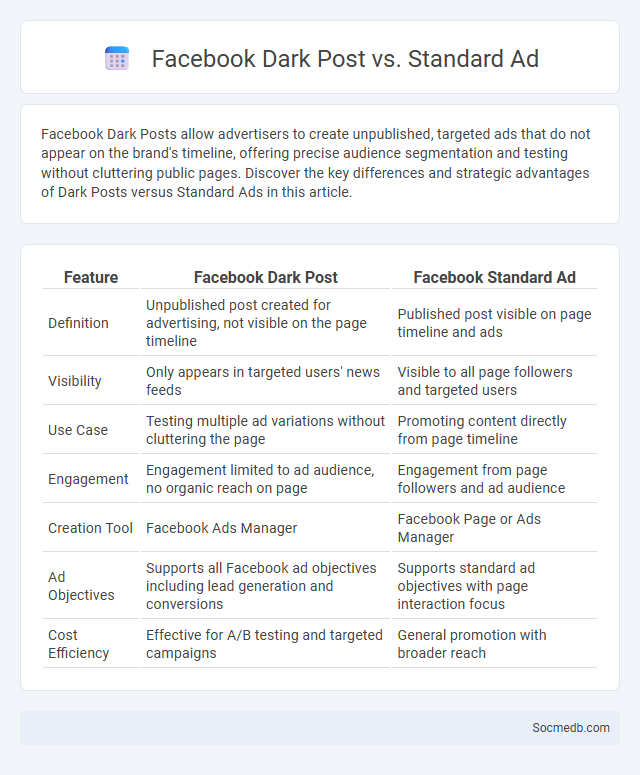
Photo illustration: Facebook Dark Post vs Standard Ad
Facebook Dark Posts allow advertisers to create unpublished, targeted ads that do not appear on the brand's timeline, offering precise audience segmentation and testing without cluttering public pages. Discover the key differences and strategic advantages of Dark Posts versus Standard Ads in this article.
Table of Comparison
| Feature | Facebook Dark Post | Facebook Standard Ad |
|---|---|---|
| Definition | Unpublished post created for advertising, not visible on the page timeline | Published post visible on page timeline and ads |
| Visibility | Only appears in targeted users' news feeds | Visible to all page followers and targeted users |
| Use Case | Testing multiple ad variations without cluttering the page | Promoting content directly from page timeline |
| Engagement | Engagement limited to ad audience, no organic reach on page | Engagement from page followers and ad audience |
| Creation Tool | Facebook Ads Manager | Facebook Page or Ads Manager |
| Ad Objectives | Supports all Facebook ad objectives including lead generation and conversions | Supports standard ad objectives with page interaction focus |
| Cost Efficiency | Effective for A/B testing and targeted campaigns | General promotion with broader reach |
Introduction: Understanding Facebook Ads and Dark Posts
Facebook Ads leverage advanced targeting algorithms to connect your brand with specific audiences based on demographics, interests, and behavior. Dark Posts, or unpublished posts, enable advertisers to run tailored ad campaigns without appearing on your public page timeline. Utilizing these tools strategically enhances engagement and drives conversions by delivering personalized content directly to your target market.
What is a Facebook Standard Ad?
A Facebook Standard Ad is a versatile advertising format that appears within users' news feeds, stories, or the Facebook Marketplace, designed to drive engagement, website traffic, or conversions. It includes a combination of images or videos, ad copy, a headline, and a call-to-action button, optimized to capture your audience's attention and deliver measurable results. Utilizing Facebook's advanced targeting options, your ad can reach specific demographics, interests, and behaviors for maximum impact.
Defining Facebook Dark Posts: Key Features
Facebook Dark Posts are unpublished ads that do not appear on your business's public timeline but are targeted to specific audiences in the News Feed. These sponsored posts enable precise demographic and interest-based targeting, allowing You to tailor content without cluttering your main Facebook page. Key features include flexible campaign testing, enhanced audience segmentation, and improved ad performance tracking for optimized marketing outcomes.
Differences Between Standard Ads and Dark Posts
Standard ads appear publicly on your social media page and in users' feeds, enhancing brand visibility and engagement organically. Dark posts are unpublished ads that target specific audiences without showing on your page timeline, allowing for precise A/B testing and tailored messaging. You can leverage dark posts to optimize campaign performance by delivering personalized content unseen by your general followers.
Benefits of Using Facebook Standard Ads
Facebook Standard Ads enhance brand visibility by targeting specific demographics based on age, location, interests, and behaviors, ensuring ad spend reaches the most relevant audience. These ads offer robust analytics tools, allowing advertisers to track performance metrics such as impressions, clicks, and conversions in real-time. Businesses gain flexibility with customizable ad formats, including images, videos, and carousels, optimizing engagement and boosting return on investment (ROI).
Advantages of Facebook Dark Posts for Marketers
Facebook Dark Posts allow marketers to create targeted, unpublished ads that do not clutter brand timelines, enabling precise audience segmentation and personalized messaging. These posts facilitate A/B testing of different ad creatives and copy without influencing public-facing content, optimizing campaign performance and budget allocation. Leveraging dark posts enhances conversion rates and return on ad spend by delivering tailored ads directly to specific user groups based on demographics, interests, and behaviors.
Use Cases: When to Choose Standard Ad vs Dark Post
Standard ads on social media are ideal for broad brand awareness and engagement, as they appear on your profile and in followers' feeds, maximizing organic reach. Dark posts, or unpublished posts, enable precise targeting without cluttering your brand's timeline, making them perfect for A/B testing, niche audience targeting, and promoting time-sensitive offers. Choosing between standard ads and dark posts depends on campaign goals, budget allocation, and the need for visibility versus tailored targeting.
Targeting and Customization: Standard Ads vs Dark Posts
Targeting and customization differ significantly between standard ads and dark posts on social media platforms. Standard ads appear on your business page and are visible to all followers, offering limited audience segmentation, while dark posts are unpublished and can be precisely targeted to specific demographics, behaviors, and interests without cluttering your profile. Using dark posts enables you to tailor your message more effectively, maximizing engagement and conversion rates with your chosen audience.
Performance Metrics: Measuring Success of Each Format
Performance metrics such as engagement rate, click-through rate (CTR), and conversion rate are crucial for measuring the success of each social media format. Video content typically shows higher watch time and shares, while image posts often generate greater likes and comments. Tracking these key indicators across platforms like Instagram, Facebook, and TikTok enables data-driven decisions that optimize content strategy and maximize ROI.
Choosing the Right Facebook Ad Strategy for Your Business
Choosing the right Facebook ad strategy for your business involves targeting the most relevant audience segments based on detailed demographics, interests, and behaviors. Leveraging Facebook's advanced analytics and A/B testing capabilities helps optimize ad performance by identifying which creatives and messages resonate best. Your campaign should balance budget allocation with clear objectives such as brand awareness, lead generation, or sales conversion to maximize return on investment.
 socmedb.com
socmedb.com